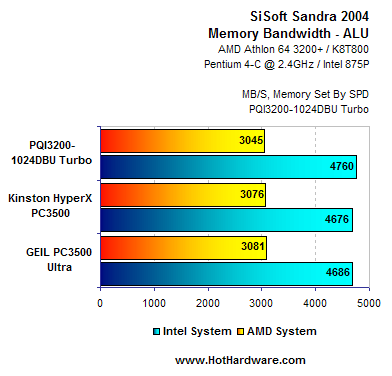PQI's PQI3200-1024DBU - Low Latency Turbo DDR400 RAM
HH Test System and SiSoft Sandra 2004
How we configured our test systems: When configuring our test systems for this review, the first thing we did was enter the system BIOS and set each board to their "Optimized" or "High-Performance Defaults". The hard drives were then formatted, and Windows XP Professional (SP2) was installed. When the installation was complete, we installed all of the necessary drivers, and removed Windows Messenger from the system altogether. Auto-Updating and System Restore were also disabled, and we setup a 768MB permanent page file on the same partition as the Windows installation. Lastly, we set Windows XP's Visual Effects to "best performance", installed all of our benchmarking software, defragged the hard drives and ran all of the tests. Throughout all our benchmarking, we had the memory voltage set to 2.8v.
|
| SYSTEM 1: S754 - AMD Athlon 64 3200+ (2GHz) MSI K8T Neo Motherboard VIA K8T800 Chipset PQI PQI3200-1024DPU Turbo Series Kingson HyperX PC3500 Geil PC3200 Ultra ASUS GeForce 6800 On-Board 10/100 Ethernet On-Board Audio WD 30GB Hard Drive 7200 RPM IDE Windows XP Pro SP2 NVIDIA ForceWare 61.77 DirectX 9.0c |
SYSTEM 2: Intel P4 2.4GHz Albatron 875P Intel 875P Chipset PQI PQI3200-1024DPU Turbo Series Kingson HyperX PC3500 Geil PC3200 Ultra ASUS GeForce 6800 On-Board 10/100 Ethernet On-Board Audio WD 30GB Hard Drive 7200 RPM IDE Windows XP Pro SP2 NVIDIA ForceWare 61.77 DirectX 9.0c |
|
|
||
First test we ran SiSoft SANDRA 2004's Arithmetic and Floating point test on the PQI3200-1024DBUs, on both AMD and Intel platforms. As a frame of reference, we compared the results to those from both Kingston HyperX PC3500 and Geil PC3500 Ultra.


Within both test sets, we saw little variation among the different modules. The PQI Memory, running at 2-2-2-5, actually registered slightly slower on the AMD system when compared to the GEIL Ultra at 2-3-3-8 and the Kingston HyperX at 2.5-3-3-8. The difference was roughly 30MB/s, which is very little in the big picture. When we switched over to the Intel platform, we saw a wider range of performance variations, with the PQI3200 Turbo Memory taking a firm lead over the GEIL and Kingston HyperX modules. On the 875P board, the PQI3200 managed to top the comparison modules by an average of 100MB/s overall, with the GEIL Ultra holding a firm second place.







